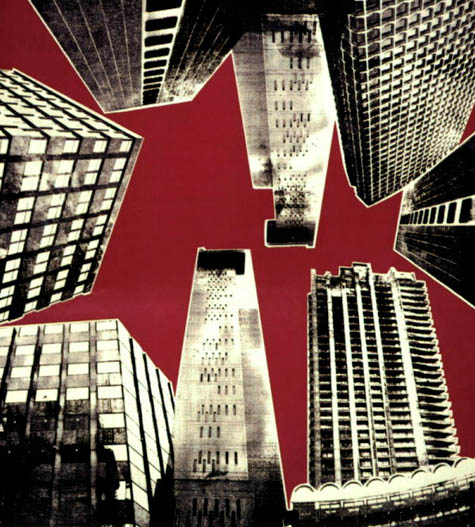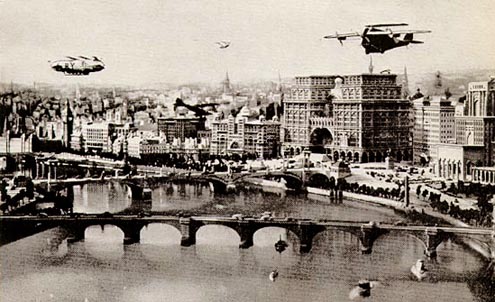London 2090 A.D.
I seem to be under the influence of H.G. Wells this week, but something about the previous post reminded me of Wells's old novel The Sleeper Awakes.
In that book we follow the shocked but exhilirated travails of a man who wakes up in London 200 years in the future – only to find that he's become some sort of Messiah...
So the plot is not exactly interesting, but the book's descriptions of architecture are extraordinary.
 [Image: Cover illustration by Kate Gibb for The Sleeper Awakes].
[Image: Cover illustration by Kate Gibb for The Sleeper Awakes].
London, we read, has become a place of "vast and vague architectural forms."
The book's central character – the Sleeper, named Graham – looks around himself, spatially overwhelmed. He becomes aware of "balconies, galleries, great archways giving remoter perspectives, and everywhere people, a vast arena of people, densely packed and cheering." Looking at the city, he says, is "like peering into a gigantic glass hive."
 [Image: An unrelated vision of London's sci-fi future from Maurice Elvey's 1928 film, High Treason, mentioned in Fantasy Architecture: 1500-2036].
[Image: An unrelated vision of London's sci-fi future from Maurice Elvey's 1928 film, High Treason, mentioned in Fantasy Architecture: 1500-2036].
Meanwhile, outside, the Thames has been drained, replaced with "a canal of sea water" fed by "vast aqueducts" that are "spanned by bridges that seemed wrought of porcelain and filigree."
And the entire place runs on wind power:
Standing beside a companion now, he tries to absorb all the things he's seeing:
Or does such a comparison collapse under further analysis? Surely such things could, and should, be assigned at the same time? They're not mutually exclusive and may even benefit from one another's company?
In that book we follow the shocked but exhilirated travails of a man who wakes up in London 200 years in the future – only to find that he's become some sort of Messiah...
So the plot is not exactly interesting, but the book's descriptions of architecture are extraordinary.
 [Image: Cover illustration by Kate Gibb for The Sleeper Awakes].
[Image: Cover illustration by Kate Gibb for The Sleeper Awakes].London, we read, has become a place of "vast and vague architectural forms."
The book's central character – the Sleeper, named Graham – looks around himself, spatially overwhelmed. He becomes aware of "balconies, galleries, great archways giving remoter perspectives, and everywhere people, a vast arena of people, densely packed and cheering." Looking at the city, he says, is "like peering into a gigantic glass hive."
- His first impression was of overwhelming architecture. The place into which he looked was an aisle of Titanic buildings, curving spaciously in either direction. Overhead mighty cantilevers sprang together across the huge width of the place, and a tracery of translucent material shut out the sky. Gigantic globes of cool white light shamed the pale sunbeams that filtered down through the girders and wires. Here and there a gossamer suspension bridge dotted with foot passengers flung across the chasm and the air was webbed with slender cables. A cliff of edifice hung above him, he perceived as he glanced upward, and the opposite facade was grey and dim and broken by great archings, circular perforations, balconies, buttresses, turret projections, myriads of vast windows and an intricate scheme of architectural relief. Athwart these ran inscriptions horizontally and obliquely in an unfamiliar lettering. Here and there close to the roof cables of a peculiar stoutness were fastened, and drooped in a steep curve to circular openings on the opposite side of the space...
 [Image: An unrelated vision of London's sci-fi future from Maurice Elvey's 1928 film, High Treason, mentioned in Fantasy Architecture: 1500-2036].
[Image: An unrelated vision of London's sci-fi future from Maurice Elvey's 1928 film, High Treason, mentioned in Fantasy Architecture: 1500-2036].Meanwhile, outside, the Thames has been drained, replaced with "a canal of sea water" fed by "vast aqueducts" that are "spanned by bridges that seemed wrought of porcelain and filigree."
And the entire place runs on wind power:
- He saw that he had come out upon the roof of the vast city structure which had replaced the miscellaneous houses, streets and open spaces of Victorian London. The place upon which he stood was level, with huge serpentine cables lying athwart it in every direction. The circular wheels of a number of windmills loomed indistinct and gigantic through the darkness and snowfall, and roared with varying loudness as the fitful wind rose and fell. Some way off an intermittent white light smote up and made an evanescent spectre in the night; and here and there, low down, some vaguely outlined wind-driven mechanism flickered with livid sparks.
Standing beside a companion now, he tries to absorb all the things he's seeing:
- All about them huge metallic structures, iron girders, inhumanly vast as it seemed to him, interlaced, and the edges of wind-wheels, scarcely moving in the lull, passed in great shining curves more and more steeply up into a luminous haze. Wherever the snow-spangled light struck down, beams and girders, and incessant bands running with a halting, indomitable resolution, passed upward and downward into the black. And with all that mighty activity, with an omnipresent sense of motive and design, this snowclad desolation of mechanism seemed void of all human presence save themselves, seemed as trackless and deserted and unfrequented by men as some inaccessible Alpine snowfield.
- Then for a time his mind circled about the idea of escaping from these rooms; but whither could he escape into this vast, crowded world?
Or does such a comparison collapse under further analysis? Surely such things could, and should, be assigned at the same time? They're not mutually exclusive and may even benefit from one another's company?





Comments are moderated.
If it's not spam, it will appear here shortly!
Are you gently building up to "Things to Come" (1936) or what? It was on one of the BBC channels last weekend - entire underground cities gleaming white and sleek... Moholy-Nagy was involved in the production in some way, Wells co-wrote the script...
I'm easing everyone into the idea that the whole blog will be about H.G. Wells...
Sounds like a great show - missed it, unfortunately, but I'll look around for a copy.
If you can't find a copy anywhere else, try here
http://www.625.org.uk/ttc/
where I discovered there's lots of images and info about the film in general.
And I really love your blog BTW.
Nice - thanks for the link. I linked your "Dream Palace" entry, by the way, up in the Quick Links section.
Glad you like the blog!
Would architecture schools maintain higher student morale – and produce more interesting work – if they assigned reading material like this, instead of, say, A Thousand Plateaus?
Great point. I think that's absolutely true...it seems like ATP, in particular, has a tendency to produce carbon-copy thought. Speculative fiction seems much more likely to me to trigger imaginative work...and in a much wider variety of people.
"Tono-Bungay" is an especially timely, thought-provoking book, IMO.
Post a Comment